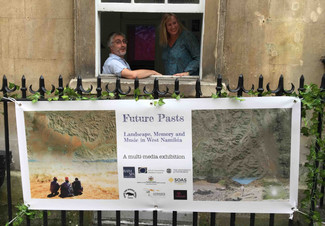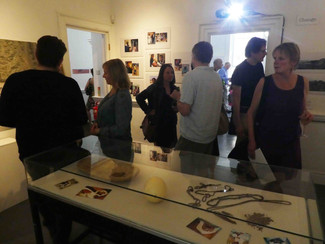Future Pasts exhibition hosts private view (and is visited by a special guest!)
- Sian Sullivan
- Jul 22, 2017
- 4 min read

On Tues 18th July, the Future Pasts research project hosted a private view of our exhibition Future Pasts: Landscape, Memory and Music in West Namibia. Held at Gallery 44AD next to the Roman Baths and the Abbey in the centre of the City of Bath, the exhibition brings together images, music and videos made in collaboration with people and organisations in west Namibia. We have aimed to create a contemplative space where the themes of sustainability, identity and displacement weaving through our research are evoked in registers beyond academic critique.
We were delighted to learn that our exhibition was selected as #pickoftheweek by Visual Arts South West, who say:
The word Namibia conjures up images of the skeleton coast and dinosaur footprints and this show uses the physical landscape as a backdrop to its focus on the Namibia of the 21st century. The collaborative and multi-disciplinary exhibition is underpinned by an academic rigour that enhances the power of the themes of ‘sustainability, identity and displacement’. With the consciences of the developed world being held in stasis by the USA, the global environmental crises that affects Namibia will get worse. This exhibition powerfully, yet peacefully, demonstrates the beauty of the country whilst highlighting issues pertinent to the people whose home it is.
At our reception on Tuesday we were joined by the Mayor of Bath, Ian Gilchrist, and the Vice-Chancellor of Bath Spa University, Professor Christina Slade, as well as many colleagues from BSU and other guests - images from this event are posted below. On Thursday our exhibition received a surprise visit from the University's Chancellor, actor Jeremy Irons, pictured here with Sian Sullivan, principal investigator of the Future Pasts project. Jeremy described the exhibition as 'extraordinary!'

The full exhibition is currently being made available online, and we will be returning this work to Namibia in 2018. To follow Future Pasts please subscribe, like us on facebook and/or follow us on twitter!
Click on one of the images below to enter slideshow. Photos taken by Owain Jones, our colleague in BSU's Research Centre for Environmental Humanities.
Acknowledgements Many people and organisations have played a part in bringing this exhibition together, and we are extremely grateful to you all!
In Bath, the enthusiasm of Katie O’Brien of Gallery 44AD and colleagues at Bath Spa University (BSU), especially in the Research Centre of Environmental Humanities, the College of Liberal Arts and the Research Support Office, has been invaluable. We particularly acknowledge John Taylor, photography technician at the Bath Spa School of Art and Design, for his essential assistance with printing the images hung at the exhibition. We also thank Tricia Hastings and Kyle Roberts at the BSU asset store who assisted with equipment bookings for the video and audio components of the exhibition, Milo Newman who helped with hanging the exhibition and Ben Mandelson who helped to bring our audio soundtrack together. We are also grateful for the use of photographs taken in association with Future Pasts by Sylvia Diez, Kara Lankers and Timm Hoffman; audio recordings by Emmanuelle Olivier (CNRS, Paris) and curated by Janet Topp Fargion (British Library); audio recordings by BBC radio journalist Robin Denselow at the Damara King’s Festival 2016; and material from the Damman sound recordings catalogue copied with permission during a 2014 research visit by Sian and Chris to the Basler Afrika Bibliographien.
In Namibia our partner organisations the National Museum of Namibia (especially Esther Moombolah Gôagoses and Eugene Marais), Save the Rhino Trust (especially Simson !Uri-||khob, Jeff Muntifering, Lesley Karutjaiva, Sebulon ||Hoëb and Alta van Schalkwyk), Gobabeb Research and Training (especially Gillian Maggs-Kölling and Theo Wassenaar), and Mamokobo Video and Research (especially Andy Botelle and Rob Scott), have supported Future Pasts in terms of logistics, stimulating conversations and friendship, as have Pat Craven, John Kinahan, Tommy Hall, Martha Akawa, and Gudrun Winston-Smith and colleagues. The Damara King’s Council Festival Organising Committee, and especially Rosa Namises, supported the making of a Future Pasts / Mamokobo film of The Damara King’s Festival 2016. We also thank the Directorate of Survey and Mapping for the aerial images shown in our exhibition, the Ministry of Environment and Tourism for the research permit that enabled Sian to travel with Franz ||Hoëb and Noag Ganaseb into the places where they once lived in the Skeleton Coast National Park, the National Archives of Namibia for various materials drawn on in our research, and Roger Nautoro, Director of the Western Youth Choir of Namibia, for use of tracks from the CD The Namibian Repertoire.
In particular we thank all those Namibians living in west Namibia who have trusted us with stories of their lives, have guided us in our research, and have become our friends. Special mention must go to Welhemina Suro Ganuses, Filemon |Nuab, Robert Gurirab, John Taniseb, Hanna |Awaras and Ulrich R. Frank.
Last, but certainly not least, our research in west Namibia would not be possible without a major research grant from the UK’s Arts and Humanities Research Council (ref. AH/K005871/2) or work permits from the Ministry of Home Affairs in Namibia, and we gratefully acknowledge this support.
































































































